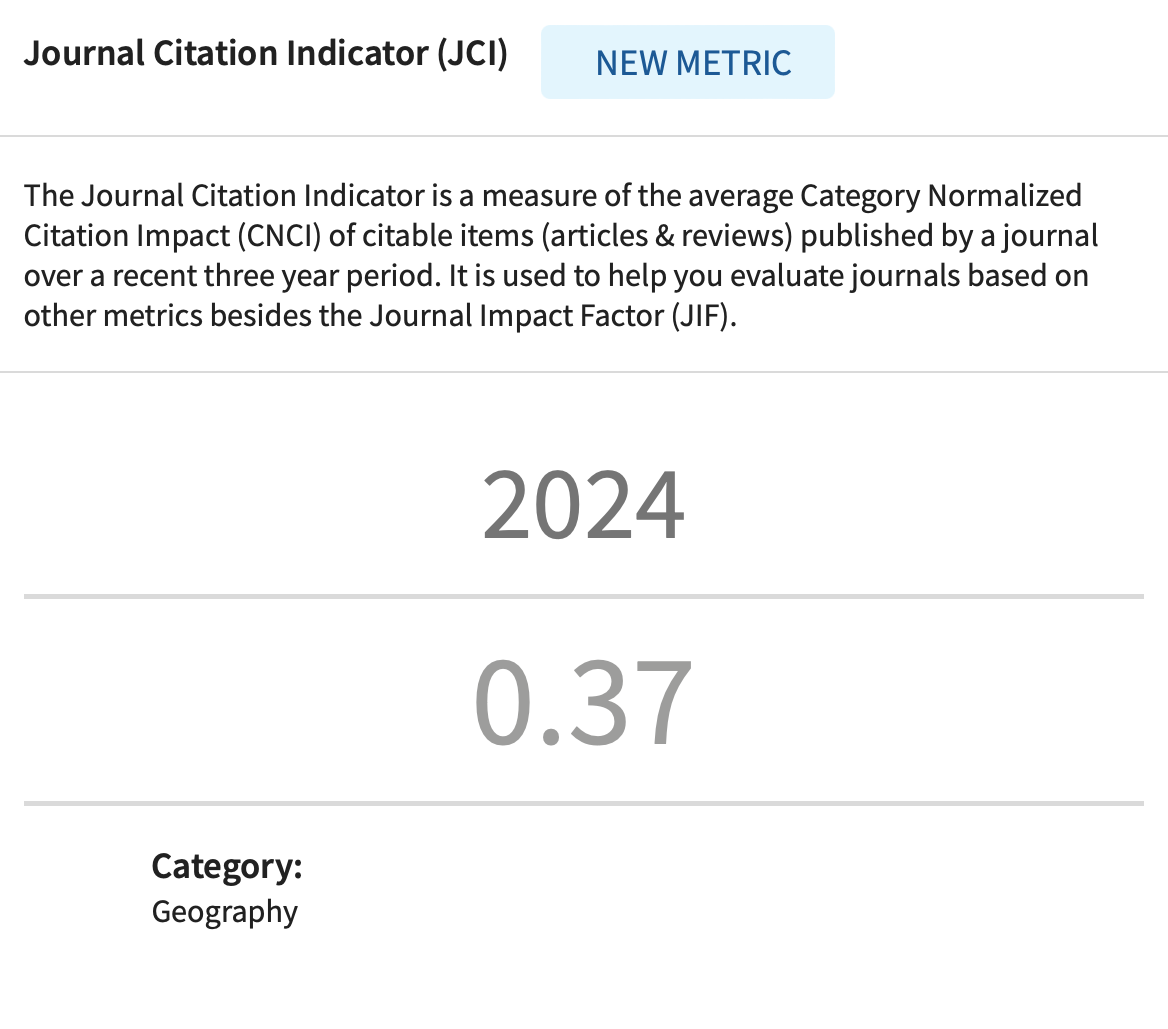INNOVATIVE APPROACHES TO SUSTAINABLE TOURISM IN HIGHLAND WETLANDS: INSIGHTS FROM COMMUNITY-BASED INITIATIVES
DOI:
https://doi.org/10.2298/IJGI241227009SKeywords:
sustainable tourism, wetland, local community, participation, Peštersko poljeAbstract
Highland wetlands might be considered as an important aspect of ecosystem functioning, preservation of biodiversity, as well as of sustenance of human livelihoods. Delicate nature of these ecosystems, coupled with the necessity for judicious natural resource utilization, has prompted extensive discourse on strategies for fostering sustainable development within highland wetlands. Perception and involvement of the local community members in sustainable development of tourism within these regions are paramount for effective tourism management and preservation of designated protected areas. This research was conducted in Peštersko polje highland wetlands, designated special nature reserve and Ramsar Site in Serbia. Situated within an isolated border region of Serbia, the Peštersko polje Ramsar Site exemplifies the characteristics typical of highland wetlands. The main aim of this study was to provide better understanding of the local community members’ perceptions of sustainable development of tourism and the manner in which their perception is affected by socio-demographic profile. The collected data were analyzed on the basis of using descriptive statistics, factor analysis, correlations, ANOVA, and independent samples t-test. Findings of this research indicated strong community support for sustainable tourism, coupled with a commitment to nature conservation. However, disparities in attitudes between residents of highland and lowland wetland regions were observed. This underscores the need to account for diverse contextual factors influencing policy formulation and planning for sustainable tourism initiatives, tailored to the specificities of each individual wetland area. Consequently, the study advocates for the adoption of guidelines aimed at fostering sustainable tourism practices within highland wetlands.
Article metrics
References
Aazami, M., & Shanazi, K. (2020). Tourism wetlands and rural sustainable livelihood: The case from Iran. Journal of Outdoor Recreation and Tourism, 30, Article 100284. https://doi.org/10.1016/j.jort.2020.100284
Adhya, T., & Banerjee, S. (2022). Impact of Wetland Development and Degradation on the Livelihoods of Wetland-dependent Communities: a Case Study from the Lower Gangetic Floodplains. Wetlands, 42(7), Article 65. https://doi.org/10.1007/s13157-022-01588-w
Bita-Nicolae, C. (2022). Distribution and Conservation Status of the Mountain Wetlands in the Romanian Carpathians. Sustainability, 14(24), Article 16672. https://doi.org/10.3390/su142416672
Buta, N., Holland, S. M., & Kaplanidou, K. (2014). Local communities and protected areas: The mediating role of place attachment for pro-environmental civic engagement. Journal of Outdoor Recreation and Tourism, 5–6, 1–10. https://doi.org/10.1016/j.jort.2014.01.001
Chakraborty, A. (2020). Mountains as a Global Heritage: Arguments for Conserving the Natural Diversity of Mountain Regions. Heritage, 3(2), 198–207. https://doi.org/10.3390/heritage3020012
Choi, H.-S. C., & Sirakaya, E. (2005). Measuring Residents’ Attitude toward Sustainable Tourism: Development of Sustainable Tourism Attitude Scale. Journal of Travel Research, 43(4), 380–394. https://doi.org/10.1177/0047287505274651
Cochran, W. G. (1977). Sampling Techniques (3rd ed.). John Wiley & Sons.
Cvetković, V. M., Gole, S., Renner, R., Jakovljević, V., & Lukić, T. (2024). Qualitative insights into cultural heritage protection in Serbia: Addressing legal and institutional gaps for disaster risk resilience. Open Geosciences, 16(1), Article 20220755. https://doi.org/10.1515/geo-2022-0755
Diaz-Christiansen, S., López-Guzmán, T., Pérez Gálvez, J. C., & Muñoz Fernández, G. A. (2016). Wetland tourism in natural protected areas: Santay Island (Ecuador). Tourism Management Perspectives, 20, 47–54. https://doi.org/10.1016/j.tmp.2016.07.005
Do, Y., Kim, S. B., Kim, J. Y., & Joo, G. Y. (2015). Wetland-based tourism in South Korea: who, when, and why. Wetlands Ecology and Management, 23(4), 779–787. https://doi.org/10.1007/s11273-015-9418-2
Enhancing the wise use and conservation of mountain wetlands, Resolution VIII.12 (2002). https://www.ramsar.org/sites/default/files/documents/pdf/res/key_res_viii_12_e.pdf
Gandarillas, V. R., Jiang, Y., & Irvine, K. (2016). Assessing the services of high mountain wetlands in tropical Andes: A case study of Caripe wetlands at Bolivian Altiplano. Ecosystem Services, 19, 51–64. https://doi.org/10.1016/j.ecoser.2016.04.006
Ghoochani, O. M., Ghanian, M., Khosravipour, B., & Crotts, J. C. (2020). Sustainable tourism development performance in the wetland areas: A proposed composite index. Tourism Review, 75(5), 745–764. https://doi.org/10.1108/TR-02-2019-0061
Gulte, E., Tadele, H., Haileslassie, A., & Mekuria, W. (2023). Perception of local communities on protected areas: Lessons drawn from the Bale Mountains National Park, Ethiopia. Ecosystem and People, 19(1), Article 2227282. https://doi.org/10.1080/26395916.2023.2227282
Hair, J. F., Hult, G. T. M., Ringle, C. M., Sarstedt, M., Danks, N. P., & Ray, S. (2021). Evaluation of Reflective Measurement Models. In Partial Least Squares Structural Equation Modeling (PLS-SEM) Using R. Classroom Companion: Business (pp. 75–90). Springer. https://doi.org/10.1007/978-3-030-80519-7_4
IBM. (2017). IBM SPSS Statistics for Windows (Version 25.0). IBM Corp.
IUCN. (2006). National Wetland Directory of Sri Lanka. Retrieved from https://www.cea.lk/web/images/pdf/7-1.Book-National-Wetland-Directory-Low%20res%281%29.pdf
Jafari, M. (2017). Investigating the Role of Tourism in the Conservation and Sustainable Development of the Environment (with an emphasis on the geographic approach). Journal of Tourism, Hospitality and Sports, 32, 51–63. https://iiste.org/Journals/index.php/JTHS/article/view/40002/41146
Kaiser, H. F. (1974). An Index of Factorial Simplicity. Psychometrika, 39, 31–36. http://doi.org/10.1007/BF02291575
Khoshkam, M., & Marzuki, A. (2011). Environmentally friendly wetlands management for tourism. WIT Transactions on Ecology and the Environment, 148, 563–571. http://doi.org/10.2495/RAV110511
Kline, R. B. (2011). Principles and Practice of Structural Equation Modeling (3rd ed). Guilford Press.
Kock, F., Berbekova, A., & Assaf, G. A. (2021). Understanding and managing the threat of common method bias: Detection, prevention and control. Tourism Management, 86, Article 104330. https://doi.org/10.1016/j.tourman.2021.104330
Kottawa-Arachchi, J. D. (2017). Biodiversity in central Highland Wetlands, a World Heritage Site in Sri Lanka. In B. A. Kumar Prusty, R. Chandra, & P. A. Azeez (Eds.), Wetland Science: Perspectives From South Asia (pp. 67–85). Springer.
Kull, C. A. (2012). Air photo evidence of historical land cover change in the highlands: Wetlands and grasslands give way to crops and woodlots. Madagascar Conservation & Development, 7(3), 144–152. http://doi.org/10.4314/mcd.v7i3.7
Law on Nature Protection, Official Gazette of the RS No. 36 (2009); 88 (2010); 91 (2010) – Corrigendum, 14 (2016); 95 (2018) – other law; 71 (2021).
Macharia, J. M., Thenya, T., & Ndiritu, G. G. (2010). Management of highland wetlands in central Kenya: The importance of community education, awareness and eco-tourism in biodiversity conservation. Biodiversity, 11(1–2), 85–90. https://doi.org/10.1080/14888386.2010.9712652
Milanović Pešić, A., Jojić Glavonjić, T., Denda, S., & Jakovljević, D. (2023). Sustainable Tourism Development and Ramsar Sites in Serbia: Exploring Residents’ Attitudes and Water Quality Assessment in the Vlasina Protected Area. Sustainability, 15(21), Article 15391. https://doi.org/10.3390/su152115391
Mitsch, W. J., & Gosselink, J. G. (2015). Wetlands (5th ed.). John Wiley & Sons.
Musasa, T., Muringaniza, K. C. R., & Manyati, M. (2023). The role of stakeholder participation in wetland conservation in urban areas: A case of Monavale Vlei, Harare. Scientific African, 19, Article e01574. https://doi.org/10.1016/j.sciaf.2023.e01574
Nath, T. K., Dahalan, M. P. B., Parish, F., & Rengasami, N. (2017). Local Peoples’ Appreciation on and Contribution to Conservation of Peatland Swamp Forests: Experience from Peninsular Malaysia. Wetlands, 37(6), 1067–1077. https://doi.org/10.1007/s13157-017-0941-1
Nešić, D. (2015). Results of the speleological exploration on Pester plateau. Bulletin of the Serbian Geographical Society, 95(4), 1–30. http://doi.org/10.2298/GSGD1504001N
Nevard, T., & Nevard, G. (2014). The Mareeba Wetlands – Conservation through sustainable ecotourism. Journal of Ecotourism, 13(2–3), 152–158. https://doi.org/10.1080/14724049.2014.998231
Obradović, S., Stojanović, V., Milić, D., Ilijević, M., Marković, V., Pantelić, M., & Puzović, A. (2024). Wise use of wetlands trough community based sustainable tourism development. Wetlands Ecology Management, 32(2), 303–326. https://doi.org/10.1007/s11273-024-09978-z
Obradović, S., Stojanović, V., Mirkov Knežević, S., & Milić, D. (2022). The importance of local community attitudes for sustainable tourism in protected areas: The case of Tikvara Nature Park, Serbia. Eastern European Countryside, 28(1), 127–153. https://doi.org/10.12775/eec.2022.006
Pan, J., Ma, Y., Cai, S., Chen, Y., & Chen, Y. (2022). Distribution patterns of lake-wetland cultural ecosystem services in highland. Environmental Development, 44, Article 100754. https://doi.org/10.1016/j.envdev.2022.100754
Pathmanandakumar, V. (2021). The influences of the socio-demographic factors on residents’ attitudes towards tourism impacts: A case study of Pasikkuda, Sri Lanka. International Journal of Research and Innovation in Social Science (IJRISS), 5(3), 9–16. https://rsisinternational.org/journals/ijriss/Digital-Library/volume-5-issue-3/09-16.pdf
Puzović, S., Vučković, V., Stojnić, N., Sekulić, G., Radaković, M., Dučić, N., Rudić, B., Ružić, M., Radišić, D., Grubač, B., Šćiban, M., & Raković, M. (2019). Birds of Pešter Plain Karst. In P. Sackl, S. Ferger, N. Sarajlić, D. Kotrošan, & G. Topić (Eds.), Dinaric Karst Poljes – Nature Conversation and Rural Development (pp. 51–85). Ornitološko društvo “Naše ptice”.
Ramírez, F., & Fennell, D. (2014). A comprehensive framework for ecotourism and wetland restoration: The case of Bogotá, Colombia. Journal of Ecotourism, 13(2–3), 128–151. https://doi.org/10.1080/14724049.2015.1011161
Ramsar & UNWTO. (2011). Wetland tourism: A great experience, responsible tourism supports wetlands and people. Retrieved from https://www.ramsar.org/sites/default/files/documents/library/ramsar-wwd2012-leaflet-en.pdf
Ramsar & UNWTO. (2012). Destination wetlands – supporting sustainable tourism. Retrieved from https://www.ramsar.org/sites/default/files/documents/library/ramsar_unwto_tourism_e_sept2012.pdf
Ramsar Sites Information Service. (2024). Pestersko Polje. Retrieved from https://rsis.ramsar.org/ris/1656?language=en
Rusciano, V., Ruberto, M., Baralla, S., Fasolino, N. G., Pellegrini, E., & Zucaro, R. (2023). Assessing the Touristic Activities of Wetlands through the Travel Cost Method: A Case Study. Water, 15(23), Article 4146. https://doi.org/10.3390/w15234146
Seifollahi-Aghmiuni, S., Nockrach, M., & Kalantar, Z. (2019). The Potential of Wetlands in Achieving the Sustainable Development Goals of the 2030 Agenda. Water, 11(3), Article 609. https://doi.org/10.3390/w11030609
Si, W., Jiang, C., & Meng, L. (2022). The Relationship between Environmental Awareness, Habitat Quality, and Community Residents’ Pro-Environmental Behavior—Mediated Effects Model Analysis Based on Social Capital. International Journal of Environmental Research and Public Health, 19(20), Article 13253. https://doi.org/10.3390/ijerph192013253
Statistical Office of the Republic of Serbia. (2014). Comparative review of the number of population 1948, 1953, 1961, 1971, 1981, 1991, 2002 and 2011 (Book 20). Statistical Office of the Republic of Serbia.
Statistical Office of the Republic of Serbia. (2024). Comparative review of the number of population 1948, 1953, 1961, 1971, 1981, 1991, 2002, 2011, and 2022. Statistical Office of the Republic of Serbia.
Stojanović, V., Milić, D., Obradović, S., Vanovac, J., & Radišić, D. (2021). The role of ecotourism in community development: The case of the Zasavica Special Nature Reserve, Serbia. Acta Geographica Slovenica, 61(2), 171–186. https://doi.org/10.3986/AGS.9411
Stone, M. T., Stone, L. S., & Nyaupane, G. P. (2022). Theorizing and contextualizing protected areas, tourism and community Livelihoods linkages. Journal of Sustainable Tourism, 30(11), 2495–2509. https://doi.org/10.1080/09669582.2021.2003371
Taber, K. S. (2018). The Use of Cronbach’s Alpha When Developing and Reporting Research Instruments in Science Education. Research in Science Education, 48(6), 1273–1296. https://doi.org/10.1007/s11165-016-9602-2
Tourism, recreation and wetlands, Resolution XI.7. (2012). https://www.ramsar.org/sites/default/files/documents/pdf/cop11/res/cop11-res07-e.pdf
United Nations. (2015). Transforming our World: The 2030 Agenda for Sustainable Development. United Nations. Retrieved December 10, 2024 from https://sdgs.un.org/2030agenda
van der Duim, R., & Henkens, R. (2007). Wetlands, poverty reduction and sustainable tourism development, opportunities and constraints. Wetlands International. https://edepot.wur.nl/31505
Wilkins, E. J., Sinclair, W., Miller, H. M., & Schuster, R. M. (2019). Does Proximity to Wetlands Matter? A Landscape-Level Analysis of the Influence of Local Wetlands on the Public’s Concern for Ecosystem Services and Conservation Involvement. Wetlands, 39(6), 1271–1280. https://doi.org/10.1007/s13157-018-1076-8
Xu, T., Weng, B., Yan, D., Wang, K., Li, X., Bi, W., Li, M., Cheng, X., & Liu, Y. (2019). Wetlands of International Importance: Status, Threats, and Future Protection. International Journal of Environmental Research and Public Health, 16(10), Article 1818. https://doi.org/10.3390/ijerph16101818
Zhang, Y., Xiao, X., Cao, R., Zheng, C., Guo, Y., Gong, W., & Wei, Z. (2020). How important is community participation to eco-environmental conservation in protected areas? From the perspective of predicting locals' pro-environmental behaviours. Science of The Total Environment, 739, Article 139889. https://doi.org/10.1016/j.scitotenv.2020.139889
Downloads
Published
How to Cite
Issue
Section
License
Copyright (c) 2025 Journal of the Geographical Institute “Jovan Cvijić” SASA

This work is licensed under a Creative Commons Attribution 4.0 International License.











